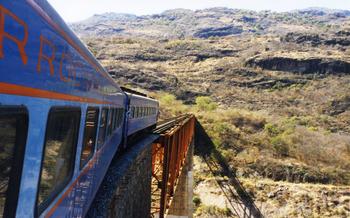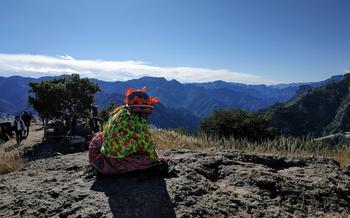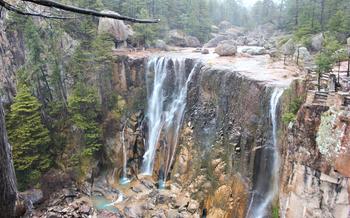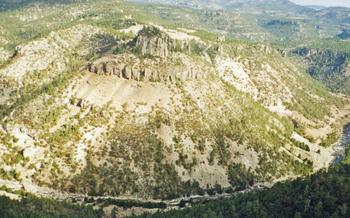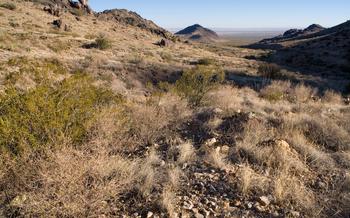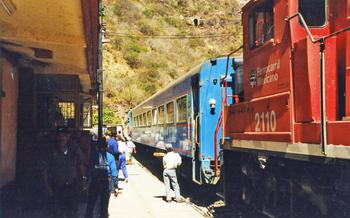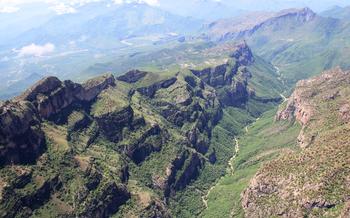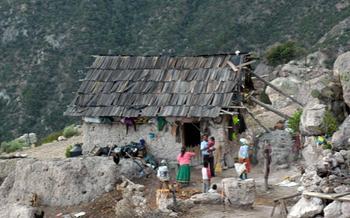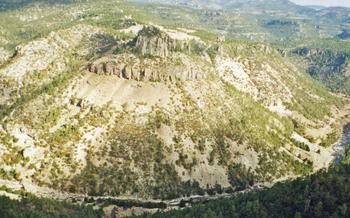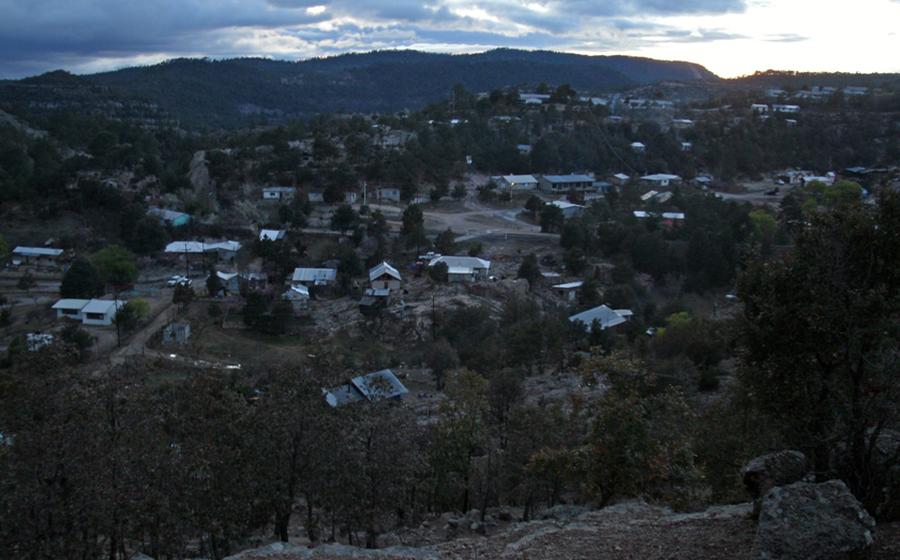
Cave Dwellings at the Sierra Tarahumara
- A Journey to the Heart of the Sierra Tarahumara
- Exploring the Ancient Caves
- Hiking and Nature Trails
- Cave Dwellers' Lifestyle
- Local Cuisine and Flavors:
- Witnessing the Deer Dance
- Breathtaking Canyons and Landscapes
- Mining Heritage of the Copper Canyon
- Tarahumara Handicrafts and Craftsmanship: A Legacy of Cultural Preservation
- Legends and Myths of the Cave Dwellers
- Best Time to Visit
- Accommodations and Amenities
- Getting There and Local Transportation
- Practical Tips for Travelers
- Insider Tip: Unveiling Hidden Gems and Unique Experiences
A Journey to the Heart of the Sierra Tarahumara
In the heart of Mexico, nestled among towering peaks and lush valleys, lies the Sierra Tarahumara, an awe-inspiring natural wonder and home to the fascinating culture of the Tarahumara people. The Sierra Tarahumara, also known as the Copper Canyon, is a vast network of canyons, rivers, and forests, renowned for its breathtaking landscapes, rich biodiversity, and the unique traditions of its indigenous inhabitants.
The Tarahumara, or Rarámuri as they call themselves, have inhabited this rugged terrain for centuries, adapting to its challenges and creating a harmonious way of life in tune with nature. The region's historical significance stems from its role as a refuge for the Tarahumara during the Spanish colonization, allowing them to preserve their cultural identity and traditions.
The cave dwellings of the Sierra Tarahumara, perched precariously on cliff faces, offer a glimpse into the unique lifestyle of the Tarahumara. These ancient caves, carved into the rock by hand, have served as homes, shelters, and ceremonial sites for generations, providing a testament to the resilience and ingenuity of the Tarahumara people.
Exploring the Ancient Caves
The cave dwellings of the Sierra Tarahumara hold a rich history and cultural significance. Inhabited for centuries by the indigenous Tarahumara people, these caves offer a glimpse into a unique way of life. The architectural features of the caves are remarkable, with intricate stonework and natural formations creating a harmonious blend of human ingenuity and the natural environment.
The Tarahumara people have a deep connection to the caves, which they consider sacred and an integral part of their identity. Their lifestyle and traditions are closely intertwined with the caves, and they continue to practice their ancient customs and rituals within these unique dwellings. The caves provide shelter, protection, and a sense of community for the Tarahumara people, who have faced various challenges throughout history.
Preservation efforts are underway to protect the cave dwellings and ensure their legacy for future generations. The Tarahumara people, in collaboration with local organizations and authorities, are working to maintain the integrity of the caves and promote sustainable tourism practices. Visitors are encouraged to respect the cultural significance of the caves and support the efforts to preserve this unique heritage.
Hiking and Nature Trails
The Sierra Tarahumara offers a diverse range of hiking trails to suit all levels of fitness and interests. Whether you're a seasoned hiker seeking an adventurous challenge or a nature enthusiast looking for a leisurely stroll, the region's stunning landscapes provide an unforgettable backdrop for your exploration.
Numerous trails wind through the canyons, leading hikers past cascading waterfalls, towering cliffs, and ancient cave dwellings. For those seeking a challenging trek, the Barrancas del Cobre Trail, also known as the Copper Canyon Trail, is a must-do. This epic trail spans over 400 miles and takes hikers through some of the most rugged and remote parts of the region, including the Urique Canyon, the deepest canyon in Mexico.
Along the trails, hikers can immerse themselves in the region's rich biodiversity. The Sierra Tarahumara is home to a wide variety of plant and animal life, including rare and endangered species. Keep an eye out for majestic birds soaring overhead, such as the golden eagle and the peregrine falcon. With a little luck, you might even spot elusive wildlife, such as the Mexican wolf or the jaguar.
For those who prefer a more leisurely pace, there are plenty of shorter and less challenging trails to choose from. These trails offer a more relaxed way to experience the region's natural beauty, taking hikers through forests, meadows, and along the rims of the canyons.
Whether you're seeking adventure or tranquility, the Sierra Tarahumara's hiking trails offer something for everyone. Embrace the opportunity to explore this breathtaking region on foot, and discover the hidden wonders that lie within its vast canyons.
Cave Dwellers' Lifestyle
The cave dwellers of the Sierra Tarahumara have a unique and fascinating way of life that has remained largely unchanged for centuries. They live in close harmony with nature, relying on traditional farming techniques and hunting practices to sustain themselves. The community is deeply rooted in its cultural heritage, with a strong emphasis on family, community, and respect for the environment.
The cave dwellers are skilled artisans, and their crafts reflect their deep connection to nature and their surroundings. They are particularly renowned for their intricate weaving, pottery, and basketry. These crafts are not only a source of income but also play a vital role in preserving their cultural identity. The traditional dances and music of the cave dwellers are also an integral part of their culture and are often performed during festivals and celebrations.
Despite the challenges they face, the cave dwellers remain resilient and proud of their unique way of life. They are committed to preserving their traditions and passing them on to future generations. Visitors to the Sierra Tarahumara have the opportunity to witness this extraordinary culture firsthand and gain a deeper understanding of the rich diversity of Mexico's indigenous communities.
Local Cuisine and Flavors:
The Sierra Tarahumara region boasts a distinct culinary tradition that showcases the unique flavors and ingredients of the region. Influenced by the Tarahumara culture and their deep connection to the land, the local cuisine offers a tantalizing array of dishes that are sure to delight your taste buds.
One of the must-try dishes is machaca con huevos, a hearty breakfast scramble made with shredded dried beef, eggs, and spices. For a taste of traditional Tarahumara cuisine, try pinole, a nutritious drink made from toasted and ground corn, which is often mixed with water or milk.
Don't miss the opportunity to indulge in the region's fresh fruits and vegetables, which are grown in the fertile valleys of the Sierra Tarahumara. From sweet peaches and apples to juicy tomatoes and chilies, the local produce is bursting with flavor.
For a truly authentic dining experience, visit one of the many local markets or restaurants. Here, you can savor traditional dishes prepared with fresh, local ingredients, while immersing yourself in the vibrant atmosphere of the community.
Food holds a significant place in the cultural identity of the Sierra Tarahumara. It is not merely a means of sustenance but a way of life, deeply connected to the land, the seasons, and the traditions of the indigenous people.
Witnessing the Deer Dance
The Deer Dance, a traditional performance of the Tarahumara people, holds immense cultural and spiritual significance in the Sierra Tarahumara. Originating from ancient hunting rituals, the dance is a mesmerizing display of grace, agility, and connection with nature. Performed by skilled dancers adorned in elaborate costumes and headdresses, the Deer Dance depicts the story of a deer hunt, symbolizing the deep respect and gratitude the Tarahumara have for the animals that sustain them.
The dance is typically performed during festivals and celebrations, with the rhythmic beating of drums and chanting creating an enchanting atmosphere. The dancers move gracefully, imitating the movements of a deer, their bodies painted with intricate designs that represent the animal's spirit. The dance is not merely a performance; it's a sacred ritual that connects the Tarahumara people with their ancestors, the land, and the deer that they rely on for sustenance.
For travelers seeking an authentic cultural experience, witnessing the Deer Dance is a must. The dance is typically performed in the villages of the Sierra Tarahumara, and visitors are welcomed to attend and observe. However, it's essential to approach the experience with respect and humility, remembering that the dance is a sacred tradition and not merely a tourist spectacle. By attending the Deer Dance, travelers can gain a deeper understanding of the Tarahumara culture and their profound connection to the natural world.
Breathtaking Canyons and Landscapes
The Copper Canyon, or Barrancas del Cobre, is a network of canyons in the southwestern part of the Sierra Madre Occidental in northwestern Mexico. It is one of the largest canyon systems in the world, larger even than the Grand Canyon in the United States. The canyons were formed by the erosion of the Rio Conchos and its tributaries over millions of years.
The Copper Canyon is home to a wide variety of plant and animal life, including many species that are found nowhere else in the world. The canyons are also home to several indigenous peoples, including the Tarahumara (Rarámuri) and the Tepehuán.
There are several ways to experience the Copper Canyon. One popular option is to take the Chihuahua al Pacífico train, which runs through the canyons and offers stunning views of the landscape. Another option is to hike or bike through the canyons. There are several trails of varying difficulty levels, so there is something for everyone.
No matter how you choose to experience the Copper Canyon, you are sure to be impressed by its beauty and grandeur. The canyons are a natural wonder that should not be missed.
Comparison with Other Famous Canyons Around the World
The Copper Canyon is often compared to other famous canyons around the world, such as the Grand Canyon in the United States and the Yarlung Tsangpo Canyon in Tibet. While all of these canyons are impressive in their own way, the Copper Canyon has several unique features that set it apart.
First, the Copper Canyon is much larger than the Grand Canyon. The Copper Canyon covers an area of 25,000 square kilometers, while the Grand Canyon covers an area of 4,926 square kilometers. Second, the Copper Canyon is home to a greater variety of plant and animal life than the Grand Canyon. This is due to the fact that the Copper Canyon is located in a more diverse climate zone.
Finally, the Copper Canyon is home to several indigenous peoples, who have lived in the canyons for centuries. These indigenous peoples have their own unique cultures and traditions, which add to the richness of the Copper Canyon experience.
Mining Heritage of the Copper Canyon
The Copper Canyon region holds a rich mining heritage that has shaped its history and culture. Over a century ago, prospectors discovered vast deposits of copper, silver, and gold within the rugged canyons. This discovery sparked a mining boom that attracted fortune seekers from around the world. The mining activities transformed the region, leading to the establishment of mining towns and fueling the local economy.
As visitors explore the Copper Canyon, they can delve into this mining heritage by visiting abandoned mines and mining towns that stand as remnants of the past. These sites offer a glimpse into the lives of miners who worked tirelessly in harsh conditions to extract precious minerals. The historic buildings, mining equipment, and artifacts provide a tangible connection to the region's mining past.
The mining heritage of the Copper Canyon not only shaped its economy but also influenced its cultural identity. The influx of miners from diverse backgrounds created a melting pot of cultures, leading to a unique blend of traditions and customs. The region's mining history is a testament to the resilience and determination of its people, who continue to preserve their heritage while embracing modern developments.
Tarahumara Handicrafts and Craftsmanship: A Legacy of Cultural Preservation
The indigenous communities of the Sierra Tarahumara are renowned for their artistic talents and craftsmanship, expressed through a variety of traditional arts and crafts. These practices hold deep cultural significance, serving as a means to preserve their heritage and identity.
Pottery, a prominent art form in the region, showcases the Tarahumara's mastery of clay. Using ancient techniques passed down through generations, artisans create intricate pottery pieces, from utilitarian vessels to decorative items adorned with symbolic designs.
Textiles, woven with vibrant colors and intricate patterns, are another hallmark of Tarahumara craftsmanship. The women of the community excel in weaving beautiful blankets, rugs, and clothing using traditional backstrap looms. Each piece is unique, reflecting the weaver's creativity and skill.
Jewelry making is another important craft, with artisans crafting exquisite pieces using silver, copper, and semi-precious stones. Their intricate designs often incorporate traditional symbols and motifs, creating one-of-a-kind pieces that are both aesthetically pleasing and culturally significant.
These traditional crafts are not merely decorative; they play a vital role in the economic and social fabric of the Tarahumara communities. The sale of handicrafts provides a source of income for many families, helping to sustain their livelihoods. Additionally, the crafts serve as a means of cultural expression and identity, allowing the Tarahumara people to share their unique heritage with the world.
Visitors to the Copper Canyon region have the opportunity to witness these artisans at work, demonstrating their skills and creating beautiful pieces that reflect the essence of the Tarahumara culture. Local markets and shops offer a wide selection of authentic handicrafts, providing visitors with the chance to purchase unique souvenirs while supporting the local economy.
Legends and Myths of the Cave Dwellers
The Tarahumara people have a rich oral tradition, passing down stories and myths from generation to generation. These tales often revolve around the cave dwellings and the region's history, weaving a tapestry of cultural beliefs and spiritual practices. Legends speak of ancient spirits residing in the caves, guiding and protecting the Tarahumara people.
One prominent legend tells of a magical cave hidden deep within the canyons, where a mystical creature known as the "Guardian of the Caves" dwells. This benevolent being is believed to possess the power to heal and grant wishes to those who approach with pure intentions.
Another myth recounts the tale of a brave Tarahumara warrior who ventured into a cave to battle a malevolent spirit that had been terrorizing the community. After a fierce struggle, the warrior emerged victorious, bringing peace and harmony back to the land.
These legends and myths are not merely stories but integral parts of the Tarahumara identity, reflecting their deep connection to the land and their ancestors. They serve as a reminder of the rich cultural heritage that continues to thrive within the cave dwellings of the Sierra Tarahumara.
Best Time to Visit
Timing is everything when planning a trip to the Copper Canyon. To make the most of your adventure, consider visiting during the dry season, which typically runs from October to May. During these months, you'll be greeted by clear skies, pleasant temperatures, and fewer crowds, allowing for a more immersive experience.
If you're interested in witnessing the vibrant cultural events that define the region, plan your visit to coincide with one of the many festivals held throughout the year. The Feast of Saint Francis of Assisi, celebrated in early October, is a particularly colorful spectacle, featuring traditional dances, music, and feasts.
To avoid the peak tourist season and enjoy a more tranquil experience, consider visiting during the shoulder months of September and June. While the weather may be slightly warmer, you'll still encounter fewer crowds and have the opportunity to connect more deeply with the local communities.
No matter when you choose to visit, the Copper Canyon offers a unique and unforgettable experience. Whether you're drawn to its breathtaking landscapes, rich cultural heritage, or warm hospitality, this extraordinary region is sure to leave a lasting impression.
Accommodations and Amenities
The Copper Canyon region offers a range of lodging options to suit different budgets and preferences. From rustic cabins and guesthouses to mid-range hotels and luxurious resorts, there's something for every traveler.
For those seeking an immersive experience, staying in a traditional Tarahumara dwelling is a must. These accommodations provide a unique opportunity to learn about the culture and lifestyle of the indigenous people. Visitors can expect basic amenities, such as beds, blankets, and a shared bathroom.
Those looking for a more comfortable stay can opt for hotels or lodges. These establishments offer private rooms with modern amenities, including hot water, Wi-Fi, and room service. Some hotels also have swimming pools, restaurants, and spas.
When selecting accommodation, consider the location and proximity to the attractions you wish to visit. If hiking is on your agenda, choose a lodge situated near the trailheads. For those interested in exploring the mining towns, staying in a hotel in one of the former mining settlements is a great option.
To ensure a hassle-free experience, book your accommodation in advance, especially if traveling during the peak tourist season. Supporting local guesthouses and homestays is a great way to contribute to the local economy and gain insights into the Tarahumara culture.
Getting There and Local Transportation
Reaching the Copper Canyon region is an adventure in itself. Several transportation options are available, depending on your starting point and preferences.
Air Travel: - The nearest airport to the Copper Canyon region is the Chihuahua International Airport (CUU). From there, you can take a connecting flight to Los Mochis Airport (LMM), which offers direct flights to several cities in Mexico. - Once in Los Mochis, you can rent a car or take a bus to the town of El Fuerte, the gateway to the Copper Canyon.
Rail Travel: - For a more scenic and historic journey, take the El Chepe train, also known as "The Train of the Copper Canyon." This iconic train winds its way through the canyons, offering breathtaking views and a unique travel experience. - The El Chepe train operates daily between Chihuahua and Los Mochis, with stops at various towns along the route.
Road Travel: - If you prefer a road trip, you can drive from Chihuahua or Los Mochis on well-maintained highways. The drive offers stunning scenery and the opportunity to explore the region at your own pace. - Rental cars are widely available in both cities, and the roads are generally safe for driving.
Local Transportation: - Once in the Copper Canyon region, you can get around using local buses, taxis, or rental cars. - Buses are a budget-friendly option and connect the major towns and villages in the region. - Taxis are readily available and can be hired for day trips or longer excursions. - Renting a car gives you the freedom to explore the region at your own pace and access remote areas.
Tips: - Plan your transportation in advance, especially during peak tourist seasons. - Consider booking train tickets well in advance, as they can sell out quickly. - Renting a car is recommended if you want to explore the region in-depth and reach remote areas. - Be prepared for long travel times, as distances between towns can be significant.
Practical Tips for Travelers
Essential Packing: Pack comfortable hiking shoes, layers of clothing for varying temperatures, a hat, sunscreen, and insect repellent. Consider bringing binoculars for wildlife viewing and a flashlight for exploring caves.
Health and Safety: Consult your doctor about vaccinations and preventive measures for diseases like malaria. Avoid drinking tap water and opt for bottled or purified water. Be cautious of wildlife, especially venomous snakes and scorpions.
Cultural Sensitivity: Respect local customs and traditions. Ask permission before taking photographs of people or sacred sites. Learn a few phrases in the Tarahumara language to show respect and facilitate communication.
Supporting Local Communities: Purchase souvenirs and crafts directly from artisans to support their livelihoods. Stay in locally-owned guesthouses and homestays to contribute to the local economy.
Interacting with Locals: Be respectful and patient when interacting with the indigenous communities. Avoid imposing your own beliefs or values. Ask questions and listen to their stories to gain a deeper understanding of their culture.
Insider Tip: Unveiling Hidden Gems and Unique Experiences
Beyond the well-trodden tourist trails, the Copper Canyon region holds a treasure trove of hidden gems and unique experiences waiting to be discovered by adventurous travelers. Venture off the beaten path to uncover enchanting waterfalls tucked away in secluded canyons, marvel at ancient petroglyphs adorning rock faces, and immerse yourself in the vibrant culture of the Tarahumara people.
-
Secret Waterfalls: Embark on a thrilling hike to discover hidden waterfalls cascading down sheer cliffs, surrounded by lush vegetation and echoing with the sounds of nature. These secluded gems offer a tranquil escape from the crowds and a chance to connect with the pristine beauty of the Copper Canyon.
-
Ancient Rock Art: Explore hidden caves and canyons adorned with ancient petroglyphs, offering a glimpse into the rich history and spiritual beliefs of the region's indigenous inhabitants. These enigmatic symbols and drawings provide a tangible connection to the past and invite you to ponder their significance.
-
Cultural Immersion Homestays: For a truly immersive experience, stay with a local Tarahumara family in a traditional dwelling. Share meals, learn about their customs and traditions, and gain insights into their way of life. This unique opportunity allows you to connect with the heart of the Copper Canyon culture and create lasting memories.
-
Artisan Villages: Discover hidden villages nestled amidst the mountains, where skilled artisans create exquisite crafts using traditional techniques passed down through generations. Watch them at work, learn about their processes, and purchase one-of-a-kind souvenirs to support their livelihoods and preserve their cultural heritage.
Remember, the true magic of the Copper Canyon lies in its hidden gems and the unique experiences it offers to those willing to venture beyond the ordinary. Embrace the spirit of adventure, explore the unknown, and create unforgettable memories in this extraordinary region.

